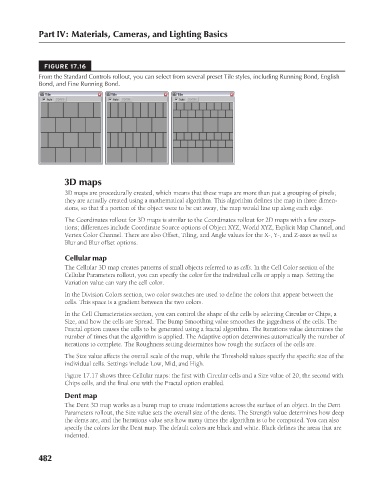Page 530 - Kitab3DsMax
P. 530
Part IV: Materials, Cameras, and Lighting Basics
FIGURE 17.16
From the Standard Controls rollout, you can select from several preset Tile styles, including Running Bond, English
Bond, and Fine Running Bond.
3D maps
3D maps are procedurally created, which means that these maps are more than just a grouping of pixels;
they are actually created using a mathematical algorithm. This algorithm defines the map in three dimen-
sions, so that if a portion of the object were to be cut away, the map would line up along each edge.
The Coordinates rollout for 3D maps is similar to the Coordinates rollout for 2D maps with a few excep-
tions; differences include Coordinate Source options of Object XYZ, World XYZ, Explicit Map Channel, and
Vertex Color Channel. There are also Offset, Tiling, and Angle values for the X-, Y-, and Z-axes as well as
Blur and Blur offset options.
Cellular map
The Cellular 3D map creates patterns of small objects referred to as cells. In the Cell Color section of the
Cellular Parameters rollout, you can specify the color for the individual cells or apply a map. Setting the
Variation value can vary the cell color.
In the Division Colors section, two color swatches are used to define the colors that appear between the
cells. This space is a gradient between the two colors.
In the Cell Characteristics section, you can control the shape of the cells by selecting Circular or Chips, a
Size, and how the cells are Spread. The Bump Smoothing value smoothes the jaggedness of the cells. The
Fractal option causes the cells to be generated using a fractal algorithm. The Iterations value determines the
number of times that the algorithm is applied. The Adaptive option determines automatically the number of
iterations to complete. The Roughness setting determines how rough the surfaces of the cells are.
The Size value affects the overall scale of the map, while the Threshold values specify the specific size of the
individual cells. Settings include Low, Mid, and High.
Figure 17.17 shows three Cellular maps: the first with Circular cells and a Size value of 20, the second with
Chips cells, and the final one with the Fractal option enabled.
Dent map
The Dent 3D map works as a bump map to create indentations across the surface of an object. In the Dent
Parameters rollout, the Size value sets the overall size of the dents. The Strength value determines how deep
the dents are, and the Iterations value sets how many times the algorithm is to be computed. You can also
specify the colors for the Dent map. The default colors are black and white. Black defines the areas that are
indented.
482
6/30/10 4:25 PM
25_617779-ch17.indd 482
25_617779-ch17.indd 482 6/30/10 4:25 PM

